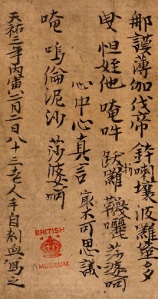
There is something compelling about the idea of a text written in blood. The 20th century Chinese writer Lu Xun once said “Lies written in ink can never disguise facts written in blood.” Here the phrase “written in blood” is metaphorical — Lu Xun was talking about the killing of student protesters — but resonates with Chinese history, as China does actually have a tradition of writing in blood. The tradition was especially present in Buddhism and the earliest surviving examples we have are from the Dunhuang manuscript collections. For example, there is a booklet containing the Diamond Sutra (S.5451) with the following colophon (as translated by Lionel Giles):
Copied by an old man of 83, who pricked his own hand to draw blood [to write with], on the 2nd day of the 2nd moon of bingyan, the 3rd year of Tianyu [27 Feb. 906].
Using one’s own blood to write Buddhist sutras is an ascetic practice, that can be included in along with other, more drastic ascetic practices that were practiced in China over the centuries, including slicing off parts of one’s flesh, burning oneself with incense, burning off a finger, or even complete self-immolation (on which, see the book by James Benn in the references). Much later, in the 17th century, a Chinese writer defended the practice of blood writing against its detractors:
Those disciples of “crazy wisdom” (kuanghui 狂慧) belittle it [blood-writing] as [involving] “corporeality” (youxiang 有相). But among the root causes of beginningless birth and death, none is deeper than the very perception of the body (shenjian 身見)… This [practice of blood-writing] is called paying reverence to the Correct Dharma; it is also called using the Dharma to make offering to Buddha. The Lotus and Śuramgama [sutras] have profound praise for incinerating one’s limbs and fingers, as well as the merits from burning incense [into one’s body]. The practices of severing the limb of afflictions and burning the body of ignorance are situated precisely in this very flesh and blood.
So, what about Tibet? It is my impression that this kind of extreme ascetic practice in general, and blood writing in particular, is historically less common among Tibetan than Chinese Buddhists. The manuscript pictured above (IOL Tib J 308) therefore strikes me as an exception. It certainly looks like it is written in blood: the colour is reddish-brown, and appears to congeal in some places. In fact, it looks much more like blood than the writing in the book by the 83-year-old man, which looks like ordinary ink. In that case, perhaps, the old man just added a few drops of blood to the inkwell.
Recently, I had the chance to have the ink in this Tibetan manuscript examined by Renate Noller, a specialist in pigment identification at the Bundesanstalt für Materialforschung und -prüfung. Her results are yet to be published, but this particular ink turned out to have a very high iron content. Now, there are inks made with iron (in the West, iron gall ink was particularly popular, and was used, for example, by Leonardo da Vinci in all his manuscripts), but that tends to darken with time to a browny-black, and lacks the clotted quality of this manuscript. If you look closely, you can see that the scribe was dipping his pen very frequently, that the ink went down very thickly and then ran out after a couple of letters.
The text that is (perhaps) written in blood in IOL Tib J 308 is the Sutra of Aparimitayus, a very popular text in Tibet, on the visualisation and the mantra of a deity representing long life and rebirth in a pure land. In the 840s thousands of scrolls of this sutra were written at Dunhuang at the behest of the Tibetan emperor, to ensure his long life through the religious merit generated by copying the sutra. This manuscript is not one of those, and to judge from its archaic orthography and “square” style, may be even older than them. Still, the motivation for copying the sutra is probably the same. If it was written in blood, this act would have given a greater value to the act of copying of the sutra, and thus to the merit generated by doing so.

* * *
References
James Baskind. 2007. “Mortification Practices in the Obaku School“, in Essays on East Asian Religion and Culture, edited by Christian Wittern and Shi Lishan, Kyoto.
James Benn. 2007. Burning for the Buddha. Honolulu: University of Hawai’i Press.
John Kieschnick. 2000. “Blood Writing in Chinese Buddhism.” JIABS 23.2: 177–194.
John Kieschnick. 2002. The impact of Buddhism on Chinese material culture. Princeton: Princeton University Press.
Jimmy Y. Yu. 2007. “Bodies of Sanctity: Ascetic Practices in Late Imperial China“. Dissertation prospectus, Princeton University. (Source of the 17th century passage above.)
Jimmy Y. Yu. 2012. Sanctity and Self-Inflicted Violence in Chinese Religions. New York: Oxford University Press.

No comments:
Post a Comment